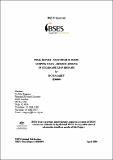| Abstract | Estimation of the incidence of sugarcane leaf diseases in the Australian sugar industry is largely confined to subjective estimates by Cane Productivity Services personnel. Resistance ratings for leaf diseases are applied to clones in the plantimprovement program through intense infield disease assessments of onfarm trials. Both methods have problems – either the inability to objectively measure diseases over large areas, or the very high time input required to capture the data. Remote sensing of leaf diseases offers the possibility of obtaining objective diseaseincidence data, both on a regional basis, but also for individual crops. Small plots in field trials also could be assessed for disease resistance through remote sensing techniques. Consultation with researchers in ENSIS and Mackay Sugar centred on the remotesensing technologies available in Australia. The one considered most suitable for initial studies is the Hyperion hyperspectral technology. This has been used previously to detect orange rust in sugarcane crops in the Mackay area. The involvement of Hyperion in initial studies would also allow the simulation of other types of remotesensing technology, such as SPOT IV, Landsat, and other multispectral detection capabilities. A threeyear research program was devised that would initially test the technology for remote sensing of leaf diseases. The adaptation of these techniques to a whole district would follow in the two subsequent years. The Herbert River district was selected as a model district, since all three major leaf diseases occur in this area (yellow spot, orange rust and brown rust) and there is a greater likelihood of obtaining satellite images in this area compared to the wet tropics (Tully). Following the successful development of the remotesensing technology, project work would involve milling and grower sectors of the industry. There would be a concentration on the uses and delivery of the crop and industry disease information, as presented in a GIS format. At the same time, research on highresolution imagery of small plots in field trials would lead to methods for assigning disease resistance ratings for clones in plantimprovement trials. This work will follow naturally on from the technology development associated with wholecrop disease detection. Researchers from both Mackay Sugar and ENSIS agree that sugarcane is a very suitable crop for remote sensing technology, with a high chance of successful disease detection. |

